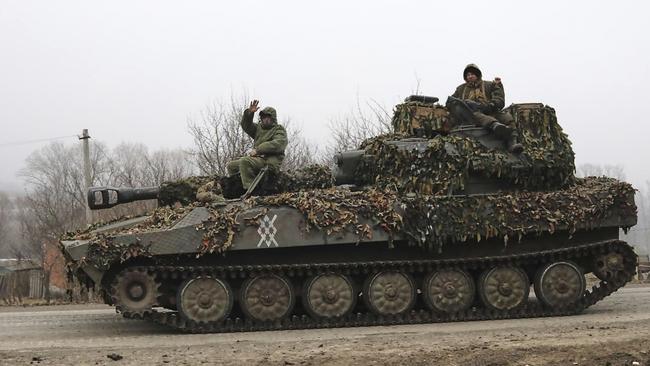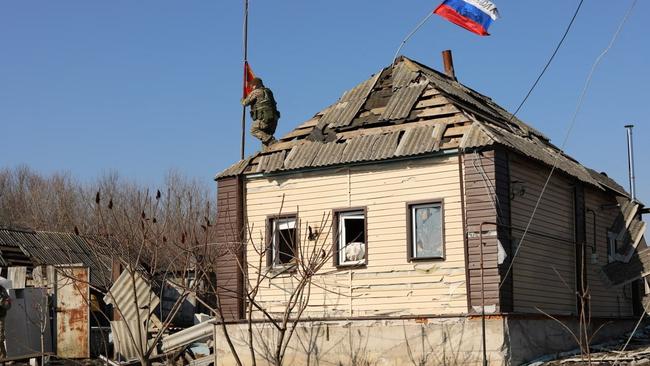Russia overpowers bold Ukrainian military venture in Kursk
Ukraine’s audacious military gambit inside Russia is drawing towards a close much as it started last year: quickly.

Ukraine’s audacious military gambit inside Russia is drawing towards a close much as it started last year: quickly.
A rapid Russian advance in recent days left remaining Ukrainian forces increasingly isolated under withering assaults, and they had pulled out from all but a sliver of Kursk province by the weekend.
The Ukrainian military’s seven-month foray surprised allies with its vigour and embarrassed Russian President Vladimir Putin. After attempting to send his army to capture Kyiv in 2022, Putin found the tables turned and became the first Kremlin leader since Joseph Stalin to face trying to oust a foreign army from his own territory.
The Russians used familiar tactics: relentless assaults with overwhelming numbers of troops – including elite units and North Korean soldiers – that ground Ukrainian forces down over months. Glide bombs smashed buildings and bunkers where Ukrainian troops sheltered. Then, in the past month, Russia deployed large numbers of drones controlled via fibre-optic cables to strike armoured vehicles on the main routes for supplying Ukrainian soldiers on a shrinking patch of land.
Ukraine had hoped to cling onto territory in Kursk as a bargaining chip in peace talks, but Ukrainian officials said it was necessary to pull out to preserve lives.
“The military command is doing what it should, preserving as many lives as possible of our warriors,” Ukrainian President Volodymyr Zelensky said.
Critics of the operation said the withdrawal proved it was a wasteful folly that squandered some of Ukraine’s best troops and their US-supplied armoured vehicles, sorely needed on other fronts in Ukraine.
But some analysts said Ukraine, outnumbered and outgunned by its giant neighbour, was justified in trying something unorthodox.
“What is one bad option among a host of bad options?” said Nick Reynolds, research fellow for land warfare at the Royal United Services Institute in London. “Ukraine has been faced with dilemma after dilemma.”

The operation, Ukrainian officials said, achieved some of its original aims: proving to Ukrainians and Western backers that the military can still launch offensives, forestalling an anticipated Russian invasion in the same area and capturing soldiers to swap with Ukrainian prisoners languishing in inhumane conditions in Russian prisons.
The operation “accomplished its task”, Mr Zelensky said at the weekend. Ukrainian forces are now defending along the hilly border to prevent a further advance by Russian and North Korean forces.
As Ukraine pulled back in Kursk, it has stabilised key parts of the front line in eastern Ukraine, pushing Russia back from the embattled city of Pokrovsk and counterattacking in the eastern city of Toretsk, which Russia had been on the verge of capturing.
The path forward, though, is fraught with military and political threats. Ukraine is stuck in a war of attrition with an enemy with a population four times its own, and the leader of Ukraine’s biggest backer, the US, is pivoting toward Russia’s position. After his envoy met with Putin, President Donald Trump on Saturday claimed thousands of Ukrainian troops were surrounded, something Ukraine’s military leadership and soldiers in the area quickly disputed as Russian disinformation.
Ukraine launched its shock offensive in Kursk just after dawn on August 6, sweeping past unprepared Russian troops.
Ukrainian soldiers had been on the defensive for months on the front line inside Ukraine. General Oleksandr Syrskiy, the country’s top military commander, later said that Ukraine couldn’t simply defend a shrinking area of land from the Russian onslaught, but also had to attack to knock the giant Russian invader off balance.
Earlier incursions over the border had been swift raids that soon withdrew. But the August assault quickly gained territory and took control of 100 villages and towns. Russia’s weighty but unwieldy war machine was stunned and struggled to respond. Only after a month did Russia fully halt Ukraine’s advance.
Then, Russia began to bring its size to bear, as it has on the front lines in Ukraine. Not only did its warplanes start dropping massive glide bombs on Ukrainian military positions, it also deployed some of its own best units to the region. Finding their armoured vehicles constantly bombarded by the Ukrainians, Russians relied on artillery, airstrikes and infantry to press forward in the difficult Kursk landscape, filled with marshes and soft ground unable to support heavy machinery during rainy seasons.
With the push, Russian troops were beginning to move forward, slowly. Ukrainians began reporting brutal tactics from Russian soldiers, including executions of prisoners who had surrendered.
Then, the North Koreans arrived.
Around 11,000 North Koreans were deployed to Kursk in December after training in Russia. Their tactics immediately stood out for their wastefulness. Ukrainians watched as North Koreans stormed across snowy fields under heavy fire, unfamiliar with modern battlefield manoeuvres but showing strength and bravery.
In one battle, Ukrainian special forces fought off waves of North Korean soldiers for eight hours, eventually running low on ammo and withdrawing after taking a prisoner who later died of his wounds.
There were North Koreans everywhere, recalled one Ukrainian soldier who took part in the battle. “It was impossible to count them,” he said. “There were too many of them.”
North Korean soldiers withdrew to regroup, reappearing again in January with improved battlefield tactics. Now, they were capable of both attacking in small groups in the style of the Russian army and in large units, which strained Ukrainian resources.
By early February, North Korean and Russian troops assaulted Ukrainian supply lines, pushing forward with infantry while Ukrainians, short on men, responded with artillery and drone fire.
Critical to the advance was a new kind of drone that Russia has deployed in increasing numbers in recent months. Guided via fibre optic cable, the drones are impervious to Ukrainian electronic jamming. With Ukrainian positions pushed back, Russia was able to deploy some of its best drone operators, who would move closer than usual to the front lines to reach targets deeper in Ukraine’s rear, Ukrainian troops said.
By early March, Ukrainian forces couldn’t move equipment in or out of Kursk without being targeted by a hail of Russian fire, making systematic evacuation of the wounded or reinforcement near impossible.
“Kursk region is collapsing because it’s really tough to reach our positions,” one Ukrainian soldier wrote in a text message. The Russians, he said, “are destroying everything”.
As the situation deteriorated late last week, General Syrskiy sped to the Kursk front. He has been criticised for acting too slowly, but aides said he has to strike a tough balance between saving the lives of troops and not giving up land too easily.
By the time General Syrskiy arrived, though, it was clear he was overseeing a withdrawal. Last weekend, soldiers in the area said supply routes to the remaining troops were under fire and largely unusable by vehicles, and artillery and drone-teams were working to hold back advances and allow them to get out.
A brief pause in US weapons deliveries and some intelligence sharing had little impact, analysts said, as the Russian advance was already rolling forward. On Thursday, Russian troops said they took control of Sudzha, the main town that the Ukrainians had occupied.
The Ukrainian retreat appeared generally organised but at times chaotic, under fire – and, for some, too late.
Images from Russian news agencies in recent days appeared to show that Russian forces captured an M1 Abrams tank and several other US-supplied armoured vehicles with the dead bodies of Ukrainian servicemen inside.
The Wall Street Journal



To join the conversation, please log in. Don't have an account? Register
Join the conversation, you are commenting as Logout